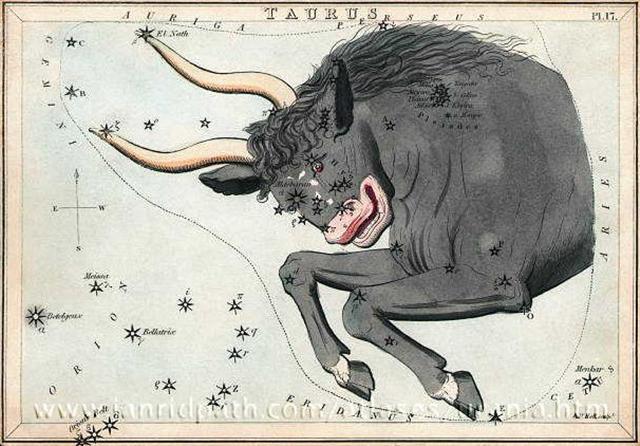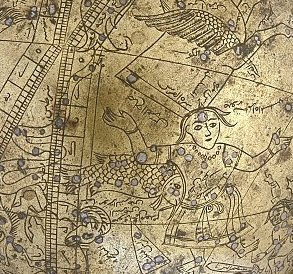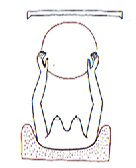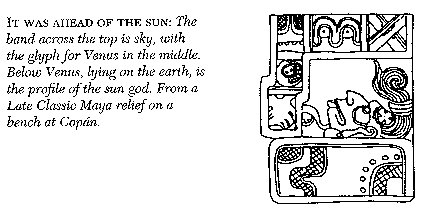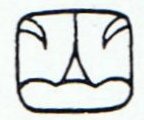84. Obviously the pair of 3-eyed maitaki glyphs could have been placed here because at the time of the Bull the right ascension line 0h had been at Hyadum II.
On Easter Island the position of Hyadum II at the Full Moon defined the corresponding place south of the equator, where once upon a time the Sun had been rising at the spring horizon in the northeast after having descended at the autumn horizon in the southwest north of the equator. My earlier guess that 3-eyed maitaki glyphs marked a solstice appears to be incorrect and also such could rather mark an equinox.
However, I have another idea, viz. that 2-eyed maitaki glyphs were used for 'female' (winter) places and 3-eyed for 'male' (summer) ones. Sirrah (the Navel of the Horse) was at the top knot of Andromeda (where Maui was born) and Bharani was at Yoni (the female organ of reproduction):
Amalthea (α Aurigae) is a name which for me sounds similar to Hamal-tea (White Leader) and also the goat mother of Zeus (with his foster brother Pan) may well have been a sign of giving birth (hanau).
... The tradition preserved by Hyginus in his Poetic Astronomy that the constellation Capricorn ('He-goat') was Zeus's foster-brother Aegipan, the Kid of the Goat Amalthea whose horn Zeus also placed among the stars, shows that Zeus was born at mid-winter when the Sun entered the house of Capricorn ...
At Ca5-12 the sign of the pole of the King (ξ) was used, which I thought could have referred to summer solstice in Roman times:
However, in order to relate this presumably 'male' type of maitaki to an equinox we need to use the timeframe of the Bull, where we can recognize MAY 15 as the date for Tau-ono (Six stones). At the time of rongorongo the Sun reached Tau-ono (the first part of the Pleiades) in May 15 (135) and in May 16 (136 = 200 - 64 = 173 - 37) he was at Alcyone, where the sailing season was beginning. ... another Alcyone, daughter of Pleione, 'Queen of Sailing', by the oak-hero Atlas, was the mystical leader of the seven Pleiads. The heliacal rising of the Pleiads in May [i.e. in MAY] marked the beginning of the navigational year; their setting marked its end when (as Pliny notices in a passage about the halcyon) a remarkably cold North wind blows ...
... As soon as one has mastered the elementary grammar and accidence of myth, and built up a small vocabulary, and learned to distinguish seasonal myths from historical and iconotropic myths, one is surprised how close to the surface lie the explanations, lost since pre-Homeric times, of legends that are still religiously conserved as part of our European cultural inheritance. For example, the various legends of the halcyon, or kingfisher which like the wren, is associated in Greek myth with the winter solstice. There were fourteen 'halcyon days' in every year, seven of which fell before the winter solstice, seven after, peaceful days when the sea was smooth as a pond and the hen-halcyon built a floating nest and hatched out her young. According to Plutarch and Aelian, she had another habit, of carrying her dead mate on her back over the sea and mourning him with a peculiarly plaintive cry. The number fourteen is a moon-number, the days of the lucky first half of the month; so the legend (which has no foundation in natural history, because the halcyon does not build a nest at all but lays its eggs in holes by the waterside) evidently refers to the birth of the new sacred king, at the winter solstice - after his mother, the Moon-goddess, has conveyed the old king's corpse to a sepulchral island. Naturally, the winter solstice does not always coincide with the same phase of the moon, so 'every year' must be understood as 'every Great Year', at the close of which solar and lunar time were roughly syncronized and the sacred king's term ended ... Pliny, who carefully describes the halcyon's alleged nest - apparently the zo÷phyte called halcyoneum by Linnaeus - reports that the halcyon is rarely seen and then only at the winter and summer solstices and at the setting of the Pleiades. This proves her to have originally been a manifestation of the Moon-goddess who was worshipped at the two solstices as the Goddess of alternatively Life-in-Death and Death-in-Life - and who early in November, when the Pleiades set, sent the sacred king his summons to death ... Counting from January 1 in the preceding year Tau-ono was day 500 and marking the final of the old year before a new year was beginning with Alcyone. The time frame of the Pleiades year was apparently later than that of the Bull. May 16 was 56 days (8 weeks) after 0h and Hyadum II was 64 = 56 + 8 days after 0h. But there were 8 dark nights before the Bull's Eye (Ain, ε Tauri) - a pattern which probably was due to that of Venus, who had 8 dark nights of invisibility before she returning as Morning Star (her 'male' appearance).
Once upon a time Zeus (Father Light, Jupiter, etc) had been reborn in midwinter (north of the equator). But this was in mythical time. Much later, at the time of the Bull the Pleiades had moved ahead considerably and at the time of rongorongo the precessional distance had increased with a further 64 days. Moving such great time distances (in the mind) makes it hard to distinguish between equinoxes and solstices. Therefore a strict map was needed, a star map where the cardinal points of the Sun were standing still. According to the Mayas their current such map dated back to 28 May in the year 3149 BC:
... This pot depicts one of the Hero Twins (One-Ahaw in the Classic texts and One-Hunaphu in the K'iche' Popol Vuh) and a great bird who is trying to land in a huge ceiba tree heavy with fruit. This mythical bird is Itzam-Yeh, Classic prototype of Wuqub-Kaqix, 'Seven-Macaw', of Popol Vuh fame. In that story, in the time before the sky was lifted up to make room for the light, the vainglorious Seven-Macaw imagined himself to be the sun. Offended by his pride, the Hero Twins humbled him by breaking his beautiful shining tooth with a pellet from their blowgun. This pot shows One-Ahaw aiming at the bird as he swoops down to land in his tree. As Itzam-Yeh lands on his perch, the text tells us he is 'entering or becoming the sky'. This particular 'sky-entering' is not the one mentioned in the Palenque text. It is the final event that occurred in the previous creation before the universe was remade. Before the sky could be raised and the real sun revealed in all its splendor, the Hero Twins had to put the false sun, Itzam-Yeh, in his place. If the date on this pot corresponds to that pre-Columbian event, as we believe it does, then Itzam-Yeh was defeated on 12.18.4.5.0.1 Ahaw 3 K'ank'in (May 28, 3149 B.C.). After the new universe was finally brought into existence, First Father also entered the sky by landing in the tree, just as Itzam-Yeh did ... In the Mayan glyph for the night (Akbal) we can see 3 signs above the ground (or clouds?), with a pair of Moon crescents flanking the central pole:
A similar design was used by them for Venus, with a pair of eyes (probably representing her morning and evening appearances) separated by her 'nose' (when she was invisible in the night sky). The rongorongo glyphs were presumably intended to show the opposite of the Mayan view north of the Equator. Therefore the horizontal orientation in the night for Akbal and for Venus had to be changed to a daytime vertical orientation:
The inside and compressed night confinement had to be changed to an outside and in fresh air view of the Tree of Father Light, to an outside view of the starry sky dome above. ... The most vivid description of hut interiors is given by Eyraud ... who slept in them several nights: Imagine a half open mussel, resting on the edge of its valves and you will have an idea of the form of that cabin. Some sticks covered with straw form its frame and roof. An oven-like opening allows its inhabitants to go inside as well as the visitors who have to creep not only on all fours but on their stomachs. This indicates the center of the building and lets enter enough light to see when you have been inside for a while. You have no idea how many Kanacs may find shelter under that thatch roof. It is rather hot inside, if you make abstraction of the little disagreements caused by the deficient cleanliness of the natives and the community of goods which inevitably introduces itself ... But by night time, when you do not find other refuge, you are forced to do as others do. Then everybody takes his place, the position being indicated to each by the nature of the spot. The door, being in the center, determines an axis which divides the hut into two equal parts. The heads, facing each other on each side of that axis, allow enough room between them to let pass those who enter or go out. So they lie breadthwise, as commodiously as possible, and try to sleep ...
... They were Ranginui, the Sky Father, and Papatuanuku, the Earth Mother, both sealed together in a close embrace. Crushed between the weight of their bodies were their many children, whose oppression deepened. They yearned to be free; they fought their parents and each other to break loose. Tuumatauenga, virile god of war, thrust and shouted; Tangaroa of the oceans whirled and surged; Tawhirirangimaatea, Haumiatiketike and Rongomatane, of wild foods and cultivated crops, tried their best but were not successful; and Ruamoko, god of earthquakes, yet to be born, struggled in the confinement of his mother's womb ... Of them all, Taane Mahuta, the god of the forests, was the most determined; he set his sturdy feet upon his father's chest, and braced his upper back and shoulders against the bosom of his mother. He pushed; and they parted. So the world, as the Maori understand it, came into being ... ... Midsummer is the flowering season of the oak, which is the tree of endurance and triumph, and like the ash is said to 'court the lightning flash'. Its roots are believed to extend as deep underground as its branches rise in the air - Virgil mentions this - which makes it emblematic of a god whose law runs both in Heaven and in the Underworld ... In other words, I suggest the maitaki type of glyph was illustrating the good time when the Sun was standing high outside (and not away up in the north). His presence could be observed from the high sky, a situation which was comparable to how high tide with only sky above and sea below had changed by the flood moving out and letting land be revealed. This happened twice in a day and for people living close to the equator the Sun stood high twice in a year. When the central ('ebb time land') part was missing - drawn as maitaki with only a pair of 'eyes' - it was winter ('night', 'high tide'), and Father Light had still to be born. Reading the glyphs like this we can see that the vertical dimension is increasing towards Cursa, towards the time of the Goat (who once upon a time should have been born not in midwinter as Zeus but in the middle of summer):
... 'fire' is actually a great circle reaching from the North Pole of the celestial sphere to its South Pole ... The 3-eyed maitaki glyphs show a maximal vertical extension and could therefore indicate that presence of 'Land' (Father Light) which was beginning at spring equinox (or according to some after the winter solstice). But in central Polynesia the Sun stood very high at both equinoxes. |
|||||||||||||||||||||||||||||||||||||||||||||||||||||||||||||||||||||||||||||||||||||||||||||||||||||||||||||||||||||||||||||||||||||||||||||||||||||||||||||||||||||||||||||||||||||||||||||||||||||||||||||||||||||||||||||||||||||||||||||||||||||||||||||||||||||||


